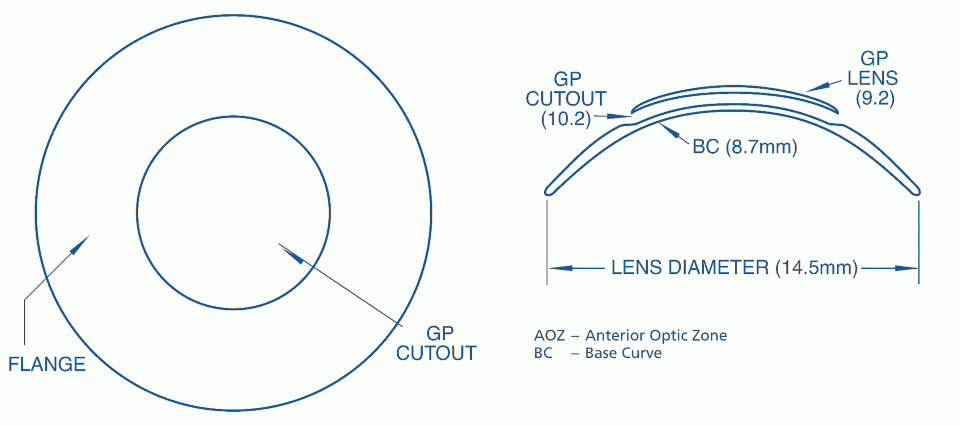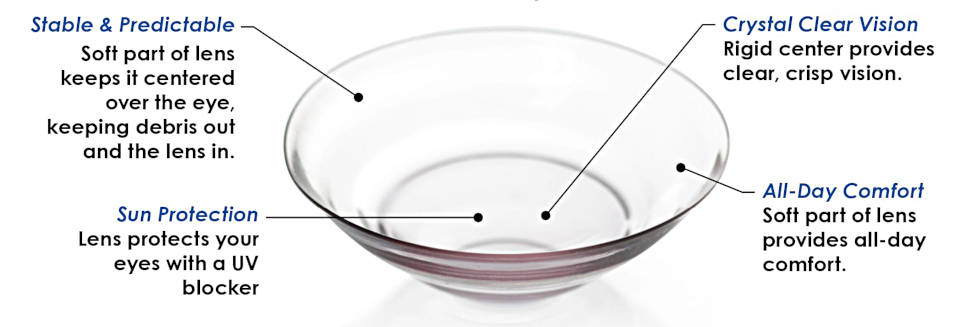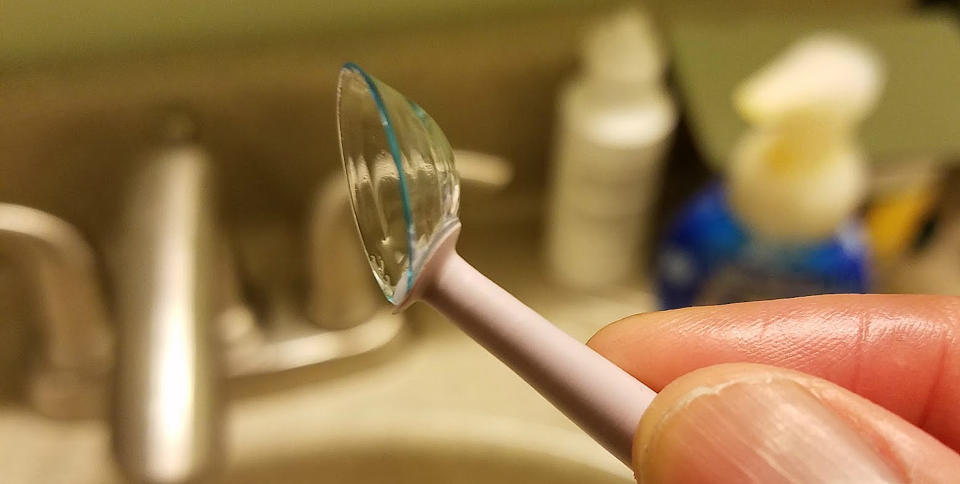Contact lenses in the treatment of keratoconus
Often contact lenses are the best way to ensure that the patient diagnosed with "keratoconus" could normally see. The contact lens installed on the eye smoothes the roughness of the cornea, and the correct optical surface is formed in front of the eye.
It should be understood, however, that contact lenses do not have a therapeutic effect in keratoconus, being only a device for vision correction. The use of contact lenses cannot stop the development of keratoconus or slow it down.
In keratoconus, various types of contact lenses can be used to improve vision: GP – hard gas-permeable, soft, hybrid, scleral, as well as combinations of hard and soft contact lenses (Piggyback).

Gas permeable contact lenses (RGP or GP)
RGP (rigid gas permeable) contact lenses are the most widely used method of improving vision in patients with keratoconus. These lenses, due to their rigidity, allow to perfectly smooth all the irregularities of the cornea, forming a completely correct front optical surface. In the optical system obtained with the use of GGP lenses, all the rays of light passing through the cornea precisely focus on the retina of the eye.
The possibility of correcting the incorrect refraction of light rays in keratoconus is provided by the rigidity of this type of contact lenses. This is their main advantage over soft lenses, which when fitting the cornea slightly smooth its curvature, but largely repeat its shape. Therefore, when using the "eye + soft contact lens" system, it is impossible to create a perfectly correct spherical shape of the front optical surface.
However, the stiffness of the lenses has a negative side. It is also the main disadvantage of rigid gas-permeable lenses, because it is associated with much less comfort for the patient and a difficult period of addiction to them, when compared with soft lenses.
The advantages of rigid gas-permeable contact lenses are:
- possibility of correction of the highest degrees of myopia and astigmatism that accompany keratoconus;
- their ability to perfectly pass oxygen to the cornea of the eye, which is very important for her health;
- easy to use and care for lenses;
- the possibility of their production on the individual order, ie, the shape of the cornea of a particular patient.
Soft contact lenses for keratoconus
Made individually soft contact lenses can be used when the patient can not use hard gas-permeable lenses due to discomfort. For the above reasons, soft lenses are often able to improve visual acuity to a much lesser extent than RGP lenses.
Combination of hard and soft contact lenses (Piggyback)
The essence of this approach is that first a soft lens is placed on the patient's eye, and on top of it – GP-lens. This achieves a combination of soft contact lens comfort with the efficiency of vision improvement inherent in hard lenses.

Hybrid lenses
Hybrid lenses combine hard and soft lenses in their device. Their Central part is a RGP lens, and the material for the periphery area (which is called the "skirt") is a soft hydrogel polymer. Compared to hard and soft lenses, the use of hybrid lenses provides the best combination of comfort for the patient and visual acuity. The first models of hybrid lenses caused complaints of patients, as often soft hydrogel material "skirt" exfoliated from the hard zone in the center of the lens. In modern hybrid lenses of the latest generation, such as "SynergEyes", this problem is completely eliminated.

Scleral lenses
Scleral lenses are called rigid gas-permeable lenses that at least partially support the sclera (white tissue of the anterior surface of the eyeball) to reduce pressure on the cornea affected by keratoconus and prevent its injury. After all, the usual hard and soft contact lenses are adjacent to the cornea and injure it.
This mechanical effect on keratoconus can cause the appearance of the scar. To reduce or completely eliminate the pressure of the lens on the cornea, the diameter of the scleral lenses should exceed the diameter of the cornea. Thus, the lens support will be partially or completely distributed to the sclera outside the cornea. This type of lens is divided into two categories: scleral and semi-scleral. Scleral lenses have a larger diameter (16-25 mm) than semi-scleral lenses (up to 15-16 mm). Polyclonally lenses also called corneoscleral, because they are its backbone are partially the cornea, and partly the cornea.

Types of contact lenses in the diagnosis of "keratoconus", which are used in Russia
In the case of a slightly pronounced keratoconus in any office of contact vision correction, it is possible to carry out the selection of soft contact lenses. However, if the keratoconus is significantly developed, this type of contact lenses is simply ineffective, and other methods of correction are required (see below).
Piggyback lenses and hybrid lenses are not selected in Russia. Unfortunately, there is also a shortage of specialists who have experience in the use of scleral lenses, but it is possible to find them. For example, in Moscow there are offices of contact vision correction, which successfully select corneoscleral lenses, the manufacture of which is established here in the capital, using high-precision foreign equipment.
Contact lenses - is this the best method of correction for keratoconus?
No, we don't think so. In our opinion, a more effective method of correction is the installation of intrastromal corneal rings (segments or ICRS), which is not only comfortable for the patient and gives a higher visual acuity, but also stabilizes the cornea (along with subsequent corneal cross-linking CXL).
The same goes for security. In the long term, the use of lenses leads to the risk of introduction of infection, trauma of the cornea, development acanthameba keratitis, in which a large percentage of cases result in clouding of the cornea and the need for penetrating or lamellar keratoplasty (corneal transplant).
If the keratoconus is stable - the best method of correction may be the implantation of intraocular contact lenses (ICL STAAR) - which are installed behind the iris, are not visible externally and do not affect the cornea.




At least it didn't come to corneal transplants.
Judging by the reviews of other people, the same problem: only the correction of vision is somehow possible with their help, but the progression of keratoconus they do not stop.
After the segments implatntation vision is better now (not 100% sure, but the astigmatism is gone), but not immediately - in two weeks or three, and immediately the effect was not.
"Yes" - stops: more than 2 years now eyesight is relatively stable (if we compare the results).
dont waste your nerves and money.
put rings at once - do not miss precious time.
oof keratoconus